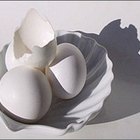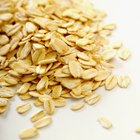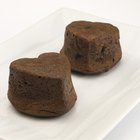
If you have ever been to a baking class or watched a serious baking demonstration, you know that stabilizers are a critical part of the baking puzzle. When your biscuits or muffins don't rise or your souffle looks like a deflated balloon, it is likely because the stabilizers within the ingredients didn't do their job. Successful baking relies on many different factors, but if the overall structure of the item is weak, you don't stand a chance.
The Role of Stabilizers
The role of stabilizers in baking is to maintain the structure of the item you are baking so it appears the way you want it to appear and tastes how you want it to taste. With so many chemical reactions happening during the preparation and baking process, the stability of the product is always in jeopardy. The stabilizers are there to ensure your breads and cakes develop gluten and hold their shape, your meringue stands tall and won't collapse and the quality of your baking remains intact.
Eggs and Flour
All baked goods have both liquefiers and stabilizers, with sugar and fats as the liquefiers and eggs and flour as stabilizers. When heat is added to a baked good, fats such as butter and various sugars turn to liquid. On the contrary, when heat is added to flour and eggs they stabilize the mixture by adding structure or coagulating the other ingredients.
Gelatin for Whipped Cream
Whipped cream is a big part of many different baked goods, and it requires stability for presentation purposes and to maintain the ideal texture. To accomplish this, gelatin is often used, especially during warmer weather or if the whipped cream must spend time on a buffet. Soften gelatin in cold water, then dissolve it by warming the water slightly. Whip heavy cream until it starts to thicken, then add your sugar and keep whipping it into the gelatin mixture until it's the consistency you want.
Cream of Tartar for Egg Whites
Egg whites are an important element of many baked goods, but unlike whipped cream they won't get a boost from gelatin when you need to make meringue or beat the whites to stiff peaks for another reason. Egg whites are a finicky ingredient and one of the easier ones to mess up when you're aiming for those fluffy peaks that resemble whipped cream. As a stabilizer for egg whites, add a pinch of cream of tartrar as you beat them. The cream of tartar will add volume to the whites and add strength to the overall structure so they don't collapse.
Related Articles

How to Substitute Cornstarch for ...

Applesauce as an Egg Substitute for ...

What Can You Use in Place of Egg Yolk ...

What Is a Substitute for Potassium ...

Heavy Whipping Cream Vs. Half & Half

Main Ingredients of English Muffins

How to Substitute Cornstarch for ...

What Does Eggs vs. Oil Do for Bread ...

Can I Substitute Bleached for ...

How to Stiffen Meringue

Does Adding an Extra Egg to Brownie Mix ...
Role of Xanthan Gum in Vegan Baking

What Works With Baking Soda Besides ...

How to Freeze Egg Whites

Merle Norman Ingredients
Baking Soda or Baking Powder to Make a ...

Purpose of Rolled Oats in Baking

Can You Use Malt Vinegar in Place of ...

Cake Emulsifier Substitute

What Is a Souffle Dish?
References
Writer Bio
Joshua McCarron has been writing both online and offline since 1995. He has been employed as a copywriter since 2005 and in that position has written numerous blogs, online articles, websites, sales letters and news releases. McCarron graduated from York University in Toronto with a bachelor's degree in English.
Photo Credits
Jupiterimages/Stockbyte/Getty Images